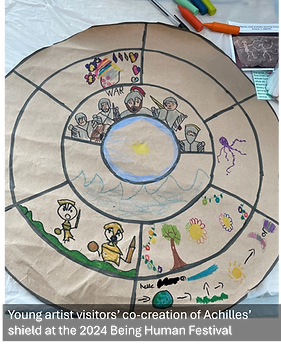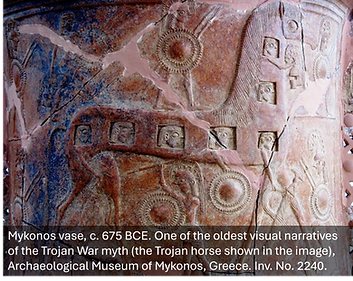Public Engagement
The project has engaged in outreach with the wider public, bringing media and ancient history to people of all ages.
2024 Being Human: A Festival for the Humanities
Making History in Cardiff
The media and ancient history team ran the activity 'War and Peace in Myth and History: Past and Present' in the Cardiff University and CAER Heritage stream of the Being Human Festival 2024.
%20(980%20x%20647%20mm).jpg)
Participants of all ages engaged creatively with representations and scenes of war and peace on artefacts and snippets of texts, from epic poetry such as Homer’s Iliad and historical texts such as Herodotus’ Histories.
Visitors were invited to co-create a new version of the Shield of the mythical hero Achilles on a collective paper artwork. The activity invited participants to reflect on continuity and change in representations of war and peace in the ancient and modern world.
The Shield of Achilles is a mythological artefact and a literary description of a weapon of war with scenes of both violence and peaceful life in its decorative motifs. It is described in Homer’s Iliad Book 18, Lines 468-608.


What did people say about the event?
'It was amazing and I enjoyed it'

‘I drew a dinosaur smashing a PUB'
‘It was really fun – thank you!’

‘Around the other city there lay two bodies of troops, agleam in their armor.’
Homer, Iliad Book 18, Lines 509-510 .
Translated by Peter Green, University of California Press, 2015.
‘Into the fire he now cast solid bronze and tin, silver and precious gold; next he set a large anvil to stand on its anvil block, and then grasped in one hand a weighty hammer, in the other his forging tongs. First he fashioned a shield, both huge and sturdy, adorned intricately all over.’
Homer, Iliad Book 18, Lines 474–479.
Translated by Peter Green, University of California Press, 2015.
This is how Flaxman interpreted the shield of the mythological hero Achilles, made by the god Hephaestus, as described in the eighteenth book of Homer’s Iliad.
You can watch a video about Flaxman's interpretation of the shield here:

‘On it the far-famed lame-of-both-legs god subtly inlaid a dancing floor like the one in spacious Knossos that long ago Daidalos fashioned for fair-tressed Ariadne. Here were young men, with maidens worth many oxen in bride-price, dancing, hands on each other’s wrists, the girls robed in fine linen, while the men wore fine-woven tunics, softly gleaming from worked-in oil.’
Homer, Iliad Book 18, Lines 590-596.
Translated by Peter Green, University of California Press, 2015.
‘A god inspired the bard to sing. He started with how the Greeks set fire to their camp and then embarked and sailed away. Meanwhile, Odysseus brought a gang of men into the heart of Troy, inside the horse.’
Homer, Odyssey Book 8, Lines 499-504.
Translated by Emily Wilson, W. W. Norton & Company, 2017.


